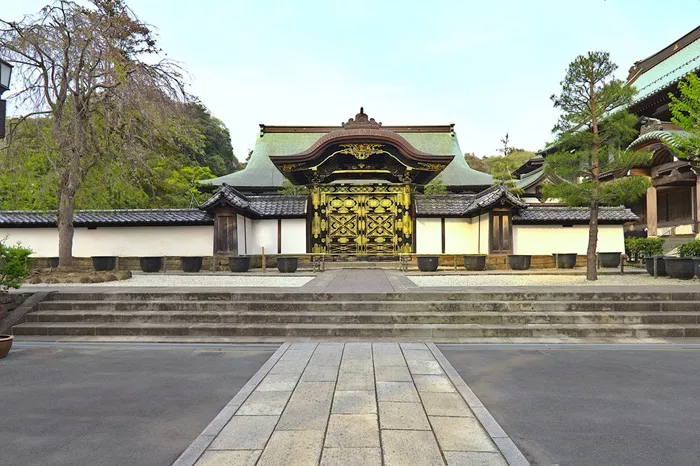Kencho-ji is one of the oldest and most important buddhist temples in Japan. It is a Zen temple located in Kamakura, a city famous for its rich history and culture. Founded in the 13th century, Kencho-ji plays a vital role in the history of Japanese Zen Buddhism.
In this article, we will explore the origins, significance, architecture, and spiritual practices of Kencho-ji. We aim to present this information in simple words for easy understanding.
The History of Kencho-ji
The Founding of Kencho-ji
Kencho-ji was founded in 1253 by the Chinese Zen master Rankei Doryu, who was invited to Japan by the Hojo regent, Hojo Tokiyori. This temple became the first of the five great Zen temples in Kamakura, which are collectively known as the Kamakura Gozan. It was built to spread the teachings of Rinzai Zen, a major school of Zen Buddhism in Japan.
Kencho-ji’s Role in Japanese Zen Buddhism
As the head temple of the Rinzai sect in Kamakura, Kencho-ji became a key center for Zen study and practice. Many monks trained here, learning meditation and Buddhist philosophy. Over the centuries, Kencho-ji helped shape Zen culture in Japan. Its influence spread beyond religion, affecting arts like calligraphy, tea ceremony, and garden design.
Kencho-ji’s Spiritual Significance
The Zen Teachings at Kencho-ji
Kencho-ji focuses on Zen meditation or zazen, a practice where practitioners sit quietly to calm their minds and realize enlightenment. The temple follows the Rinzai tradition, which emphasizes sudden insight through meditation and koan study (koans are paradoxical questions or stories used to provoke deep thought).
Training and Monastic Life
The temple serves as a training ground for monks who want to deepen their understanding of Zen. They engage in rigorous meditation, chanting, and study. Visitors can often witness or participate in meditation sessions, offering a glimpse into monastic life.
The Architecture of Kencho-ji
Overview of Temple Architecture
Kencho-ji’s buildings represent classic buddhist architecture in Japan. The temple complex is large and set in a peaceful forested area. The layout is designed to support both meditation and daily rituals.
Main Structures of Kencho-ji
Some of the most important buildings in Kencho-ji include:
- Sanmon Gate: This grand gate welcomes visitors and marks the entrance to the temple grounds. It is a symbol of the transition from the everyday world to the sacred space of the temple.
- Hatto (Dharma Hall): The hall where monks gather to hear sermons and conduct ceremonies.
- Kuri (Kitchen and Living Quarters): This building houses the temple’s kitchen and monks’ living spaces.
- Butsuden (Main Buddha Hall): The hall where the main Buddha statue is enshrined.
- Zendo (Meditation Hall): The place dedicated to Zen meditation practice.
Garden and Natural Surroundings
The temple gardens and natural surroundings are designed to enhance calmness and reflection. Walking through the temple’s mossy paths and tall cedar trees helps visitors connect with nature and find peace.
Cultural and Tourist Importance
Kencho-ji as a Cultural Heritage Site
Kencho-ji is not only a religious site but also a cultural treasure. Its buildings and gardens are protected as important cultural properties in Japan. The temple hosts various cultural events, including Zen meditation workshops and tea ceremonies.
Visiting Kencho-ji
Many people visit Kencho-ji every year. It is popular with both Buddhist practitioners and tourists who want to learn about Zen and enjoy the serene atmosphere. Visitors can explore the temple grounds, see historic structures, and sometimes join meditation sessions.
Kencho-ji’s Place Among Buddhist Temples in Japan
Comparison with Other Kamakura Temples
Kamakura is home to many famous temples, but Kencho-ji stands out as the oldest Zen temple in the city. Unlike purely Shinto shrines or Pure Land Buddhist temples, Kencho-ji represents the disciplined and meditative spirit of Zen Buddhism.
The Legacy of Kencho-ji
Kencho-ji’s legacy lives on through its continued role in training monks and preserving Zen traditions. It is a symbol of Japan’s deep connection to Zen Buddhism, inspiring people worldwide.
Conclusion
Kencho-ji is a remarkable buddhist temple with a long history and deep spiritual importance. From its founding in the 13th century to its role today, it remains a center for Zen practice and cultural heritage. Its temple architecture reflects the peaceful and simple values of Zen, while its teachings continue to guide many on the path to enlightenment.
Whether you are interested in Buddhism, Japanese culture, or simply seeking a quiet place for reflection, Kencho-ji offers a unique and profound experience.

